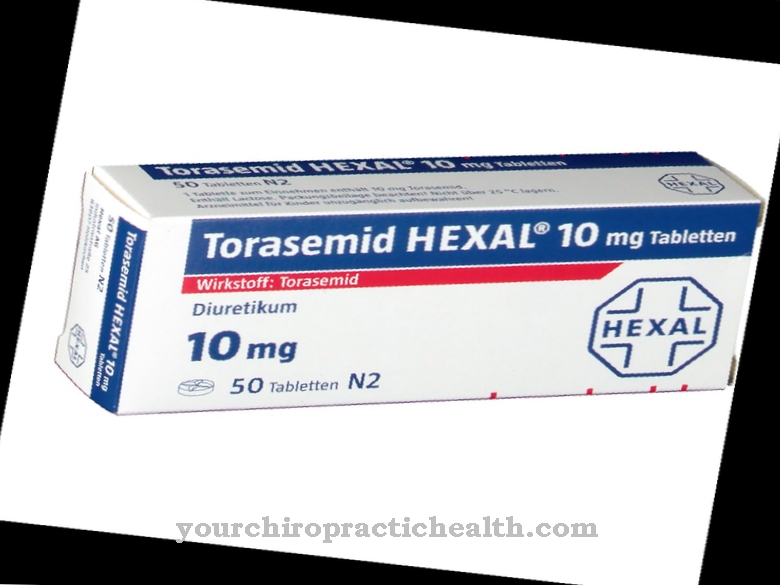With the drug Cefotiam it is an active ingredient that belongs to the category of cephalosporins. Cefotiam is an antibiotic and is primarily effective against gram-positive aerobic germs. However, the drug is also effective against some gram negative bacteria. For this reason, the drug is suitable for treating numerous infections caused by bacteria.
What is Cefotiam?
Cefotiam is a second generation cephalosporin antibiotic. In the majority of cases, the drug is administered parenterally. The antibiotic is characterized by a relatively broad spectrum of activity and is particularly effective against gram-positive and special gram-negative pathogens.
In addition, the active ingredient cefotiam is a so-called beta-lactamate. These substances are characterized by the fact that they inhibit the synthesis of cell walls in bacteria. As a result, the bacteria are no longer able to divide and multiply undisturbed. Instead, the bacterial cells die under the action of cefotiam.
Originally the drug Cefotiam was under the trade name Pansporin Launched on the Japanese market in 1981. It was also available as a generic until 1993.
Pharmacological effect
Cefotiam is characterized by a special mechanism of action and is therefore suitable for treating certain infections that are triggered by sensitive bacteria. Basically, the way the drug works is based on the fact that Cefotiam affects and inhibits the formation of bacterial cell walls. The germs are firmly bound to so-called transpeptidases. The advantage of this process is that resistance to the active ingredient only develops in very rare cases.
The drug cefotiam, for example, has an effect against gram-positive staphylococci and streptococci. On the other hand, certain types of gram-negative bacteria show resistance to beta-lactamate. The drug is particularly effective against numerous types of enterobacteria, such as Enterobacter, Escherichia coli, Salmonella, Klebsiella and certain types of Proteus. Cefotiam is also effective against Haemophilus influenzae, meningococci, gonococci as well as against anaerobes and Shigella.
In the context of clinical use of Cefotiam, observations indicate that the active ingredient is increasingly accumulating in certain types of tissue. This includes, for example, the tissue of the kidneys, heart, prostate, ears and the genital area. In addition, the medicine builds up in certain body fluids and secretions.
Medical application & use
Due to its special mode of action and its broad spectrum of action, the active ingredient cefotiam is suitable for the treatment of numerous infectious diseases that are caused by certain bacteria.
It is used in particular to treat infections that affect the upper and lower respiratory tract. These include, for example, bronchitis, pharyngitis, pneumonia, tonsillitis, otitis media and inflammation of the paranasal sinuses (sinusitis).
In addition, the drug Cefotiam is also suitable for the treatment of pyelonephritis, infections of the lower urinary tract and inflammation of the bladder.
The drug is primarily administered orally in the form of solid tablets. There is also the option of using the active ingredient Cefotiam intravenously. Appropriate injection solutions are available for this purpose.
Risks & side effects
During or immediately after therapy with Cefotiam, a number of undesirable side effects and other complaints caused by the active ingredient are possible. These side effects vary in their severity and composition depending on the individual case.
In principle, the potential side effects occur with different frequencies. In some cases, for example, after taking cefotiam, rashes on the skin, swelling of the joints or so-called Quincke's edema occur. In addition, the concentrations of creatinine and urea rise in some cases, which can be determined by examining blood or urine.
Sometimes the affected patients complain of vomiting and nausea as well as pain in the abdominal region while taking the antibiotic. Symptoms such as diarrhea, thrombocytopenia, anemia, leukocytopenia or granulocytopenia are also possible.
In some cases, symptoms similar to those of vitamin B12 deficiency develop while taking the drug. Some patients are allergic to the active ingredient, which in the worst case scenario leads to anaphylactic shock. For this reason, the drug must never be prescribed if there are known intolerances to a drug from the same group of active substances.
Serious but rare complications also include acute kidney failure and hepatitis. In addition, stomatitis and jaundice can sometimes develop when the drug is taken.
During treatment with Cefotiam, it should be noted that the drug will interact with some other active substances. The antibiotic may affect the effectiveness of oral contraceptives, probenecid, chloramphenicol and warfarin.
In principle, the drug should not be taken if an allergy to cefotiam or other cephalosporins is known. Treatment with Cefotiam should also be avoided in the case of intolerance to penicillins and beta-lactam antibiotics. Cefotiam must also not be used during pregnancy and breastfeeding.









.jpg)



.jpg)



.jpg)







.jpg)


